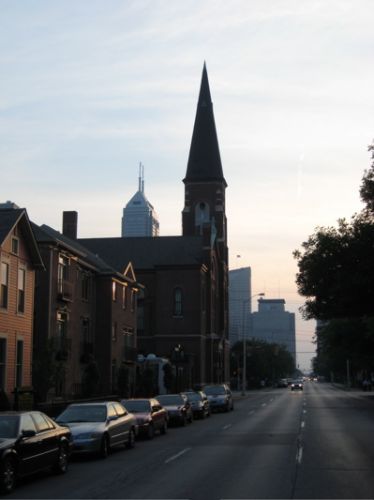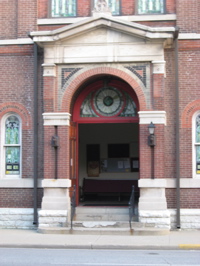 One of my favorite religion reporters is Robert King from The Indianapolis Star. A certain amount of my enjoyment reading his pieces comes from the fact that he writes about my local Hoosier Heartland community, but I think I can say objectively that King generally gets religion in his work as a journalist, and I've heard others around the community reflect similar thinking. He also knows the Indianapolis community.
On the cover of Sunday's Metro section, King wrote about a struggling downtown United Methodist congregation that meets in one of the cities many aging, beautiful and historic church buildings. The church is a combination of two "dying" downtown churches with a history in the community that spans more than 125 years, as King notes later in the article. (Also see accompanying photo gallery of one of the church's events).
One of my favorite religion reporters is Robert King from The Indianapolis Star. A certain amount of my enjoyment reading his pieces comes from the fact that he writes about my local Hoosier Heartland community, but I think I can say objectively that King generally gets religion in his work as a journalist, and I've heard others around the community reflect similar thinking. He also knows the Indianapolis community.
On the cover of Sunday's Metro section, King wrote about a struggling downtown United Methodist congregation that meets in one of the cities many aging, beautiful and historic church buildings. The church is a combination of two "dying" downtown churches with a history in the community that spans more than 125 years, as King notes later in the article. (Also see accompanying photo gallery of one of the church's events).
One church was founded in 1877, and started what is today one of the area's largest hospitals. Indiana's senior Senator and former Indianapolis Mayor Richard Lugar was once a member. Immigrants founded the other in 1880. Services at this church were held in German initially.
With that background in mind, the article left me pondering whether this story was more about a growing social center and movement or place of entertainment than it was about a struggling church, as its traditionally defined. In fact, that was the point of the article:
As 24-year-old member Hilary Updike, Jordan's wife, says: "I think we are all kind of burnt out on the traditional church model."
The consensus among members is that Lockerbie Central now sits squarely in the emergent church movement – characterized by its emphasis on the arts, social justice causes and a willingness to question long-held traditions and conventions.
At Lockerbie Central, it also reflects something of a backlash against the conservative, suburban megachurch that has come to dominate much of the religious and political landscape.
Reporting on the "emergent church" movement is never easy. Sometimes the point of the movement is to defy any traditional labels that reporters can slap on the congregation. Check out this section of King's story:

Now, the room the German immigrants and generations of churchgoers used as a fellowship hall features a temporary display of "fringe" artists.
Prominent among them is a painting of President Bush who, though a famous United Methodist himself, is featured here with horns protruding from his head. The caption above him carries the apocalyptic message of many a street preacher: "The End is Near."
And in lieu of a pastor, the church this week is giving itself, heart and soul, to an experiment in worship in which everyone participates in a communal service. Today's highlight will be a "piece" poem cobbled together from the words audience members scribble on cards.
The closest thing to preaching – a five-minute "sermonette" – will challenge the view that Jesus would not have approved of the atomic bombing of Hiroshima, which occurred 63 years ago this week.
King's reporting reveals something unique about this congregation: while they average about 30 worshippers on Sunday, about 2,400 people come through the church every month on days not traditionally known as the Sabbath. The church has so much going on that King aptly describes the place as "perhaps the busiest church in danger of dying in Indianapolis."
The one thing I kept looking for in the story was an explanation for the church's views on the direction of the United Methodist denomination nationally or some sort of determination of the church's theological baseline. Of course since the congregation lacks a pastor and by definition attempts to avoid religious and political labels, that basis is difficult to establish, but there are certain basic things that can be asked about.
For example, there is the Apostles' Creed and the Nicene Creed. Both are generally accepted by Methodists. Are these every used in the church's worship? Why not ask the tmatt trio questions? I am sure others can think of many ways of giving readers a sense for what this group of people believes.
I also wondered whether there are other churches in Indianapolis that would call themselves "emerging." Actually, I know there are. Will they also be written about?
Photo by author of post taken in downtown Indianapolis.
